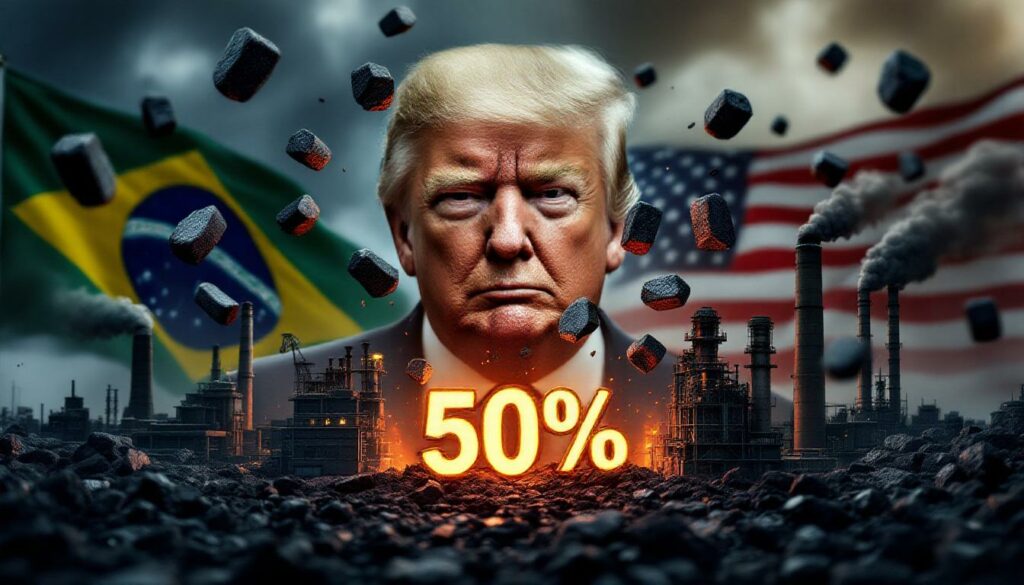The US-Brazil Pig Iron Trade Relationship: What's at Stake?
The relationship between the United States and Brazil in the pig iron market represents a critical economic pillar for both nations, with significant implications for global steel production. This longstanding trade connection has recently come under threat, creating ripple effects across international metals markets and industrial supply chains.
Understanding the Critical US-Brazil Pig Iron Supply Chain
The United States has historically relied heavily on Brazilian pig iron imports to fuel its steel production sector. Brazil currently serves as the largest supplier to the American market, providing high-quality material that meets stringent manufacturing requirements. According to Brazilian government data, approximately one-third of Brazil's pig iron exports in the first half of 2024 went directly to US customers, highlighting the interdependence of these economies.
This trade relationship represents far more than just commodity exchange—it forms a cornerstone of Brazil's metallurgical sector and supports thousands of jobs across both nations. Brazilian producers have developed specialized production capabilities specifically tailored to US market requirements over decades of partnership.
What Is Pig Iron and Why It Matters
Pig iron serves as the essential intermediate product between iron ore and finished steel, containing approximately 4% carbon along with varying amounts of silicon, manganese, and other elements. The material derives its unusual name from the traditional casting method where molten iron was poured into molds arranged in sand beds resembling suckling piglets.
In steel production, pig iron provides several critical functions:
- Serves as the primary feedstock for electric arc furnaces and basic oxygen furnaces
- Provides essential carbon content needed for steel strength and durability
- Offers a more refined starting material than raw iron ore, reducing processing steps
- Enables precise metallurgical control in specialty steel manufacturing
Brazilian pig iron is particularly valued for its consistent quality, appropriate chemical composition, and competitive pricing compared to domestic US production alternatives. American manufacturers have optimized their processes around these specific material characteristics, making substitution challenging and potentially costly.
What Triggered the Current Tariff Crisis?
The established US-Brazil pig iron trade relationship now faces unprecedented disruption due to significant policy shifts and geopolitical tensions.
Trump Administration's 50% Tariff Threat
President Donald Trump has threatened to impose a substantial 50% tariff on Brazilian pig iron imports starting August 1, 2025. This proposed tariff represents a dramatic escalation from previous trade measures and would fundamentally alter the economics of the US-Brazil pig iron trade. The Trump tariff plans follow a broader pattern of increased protectionist trade measures targeting key US trading partners.
Industry analysts note this potential levy would likely make Brazilian imports economically unviable for many US buyers, effectively closing access to America's largest export market for Brazilian producers. The timing of the announcement has created immediate market uncertainty, with both buyers and sellers struggling to develop contingency plans.
Stalled Trade Negotiations
Diplomatic efforts to address the tariff concerns have shown little progress. Trade negotiations between Brazil and the United States have not advanced as industry participants had hoped, leaving companies on both sides in a precarious planning position.
Brazilian industry representatives, including union leader Fausto Varela of Sindifer (the Brazilian pig iron industry association), have begun engaging with Brazilian lawmakers to advocate for government intervention. According to Varela, "It is almost impossible to redirect these sales to other markets in the short term. If there is no market, there is no way around it: we'll stop."
The lack of diplomatic resolution has created significant market uncertainty, with companies unable to make informed investment or operational decisions while the tariff threat remains unresolved.
How Are Brazilian Producers Responding?
Facing potential market closure, Brazilian pig iron manufacturers have begun implementing dramatic operational changes to mitigate financial losses.
Production Shutdowns and Operational Adjustments
Modulax, a major Brazilian pig iron producer, has announced plans to halt operations entirely beginning next week. Rather than continuing production without clear sales channels, the company is accelerating maintenance work originally scheduled for later in the year.
Modulax CEO Geraldo Basques confirmed the indefinite nature of the shutdown, stating there is "no date to resume production" due to ongoing trade concerns. This approach allows the company to utilize the downtime productively while avoiding inventory accumulation of potentially unmarketable product.
Industry experts note that such maintenance accelerations may help companies weather short-term market disruptions but cannot sustain operations long-term if the tariff situation remains unresolved.
Inventory Management Strategies
CSS Siderurgica Setelagoana, another significant Brazilian producer, has adopted a different approach by continuing to operate through the depletion of existing raw material inventories. The company has warned stakeholders it may be forced to close operations entirely once these stockpiles are exhausted.
This strategy provides a temporary buffer period during which:
- Existing orders can be fulfilled while minimizing new material purchases
- Workers remain employed in the short term
- The company maintains operational readiness for quick restart if the situation resolves
- Cash flow continues while avoiding additional raw material investment
Other producers across Brazil's pig iron industry are implementing similar inventory management approaches while awaiting greater tariff clarity. These strategies represent short-term solutions that cannot sustain the industry if the US market remains effectively closed.
Workforce Impact and Labor Concerns
The human impact of the trade dispute has become an immediate concern for the industry. Brazilian producers are considering granting paid leave to workers as an initial response to the production slowdowns. However, industry-wide layoffs appear increasingly likely if the situation remains unresolved beyond the short term.
The industry union Sindifer has reported that some US buyers have already suspended contracts in anticipation of the tariffs, creating immediate revenue impacts that will eventually translate to workforce reductions. Regional communities heavily dependent on pig iron production may face significant economic hardship if the industry experiences prolonged shutdown.
What Are the Market Implications?
The threatened tariffs have created immediate disruptions across the pig iron supply chain, with potentially far-reaching consequences for steel markets globally.
US Buyer Reactions and Market Hesitation
US importers have adopted a wait-and-see approach before accepting potentially higher-priced materials. This hesitation reflects:
- Uncertainty about final tariff implementation and potential exemptions
- Exploration of alternative supply sources, though limited
- Consideration of passing increased costs to downstream customers
- Evaluation of production adjustments if material costs rise significantly
Contract suspensions have already begun, creating immediate revenue impacts for Brazilian producers even before official tariff implementation. Long-established supply relationships are being reevaluated as US buyers assess their vulnerability to policy changes.
Limited Alternative Market Options
Industry representatives have emphasized the significant challenges in market diversification, with Sindifer's Fausto Varela noting it is "almost impossible to redirect these sales to other markets in the short term."
This difficulty stems from several factors:
- Geographic constraints that make shipping to distant markets economically challenging
- Established supplier relationships in alternative markets that limit new entrant opportunities
- Technical specifications and quality requirements that vary between regional markets
- Logistical infrastructure optimized for US-Brazil trade routes
The specialized nature of the pig iron trade, with its specific quality requirements and high transportation costs relative to value, creates significant barriers to rapid market reorientation.
Potential Price and Supply Chain Effects
If implemented, the tariffs impact markets would likely trigger cascading effects throughout global steel markets:
- US steel producers may face higher input costs if forced to source pig iron at premium prices
- Alternative suppliers like Ukraine, Russia, and India could see increased demand but lack capacity for complete substitution
- Supply chain disruptions could impact downstream industries dependent on steel products, including automotive, construction, and manufacturing sectors
- Price volatility may increase as buyers and sellers adjust to the new trade reality
Industry analysts anticipate that should the tariffs proceed as threatened, US steel producers would face difficult choices between absorbing higher costs, passing increases to customers, or seeking material substitutes that may affect product quality.
What Are the Broader Economic Consequences?
Beyond immediate market disruptions, the Brazil and US tariff on pig iron situation threatens wider economic impacts across multiple sectors and regions.
Impact on Brazil's Metallurgical Sector
The pig iron industry represents a significant component of Brazil's metallurgical exports and industrial base. Production shutdowns could trigger:
- Direct job losses at pig iron facilities, potentially numbering in the thousands
- Indirect employment impacts across supporting industries and services
- Reduced economic activity in regions with high concentration of metallurgical production
- Long-term competitiveness challenges if production facilities face extended closures
Brazil's metallurgical sector has invested significantly in capacity and capabilities targeted specifically at US market requirements. Rapid redirection of this specialized production presents substantial technical and commercial challenges.
Potential US Manufacturing Disruptions
US steel producers dependent on Brazilian pig iron may experience production challenges if alternative sources cannot be secured quickly. These disruptions could manifest as:
- Higher input costs affecting profitability and pricing
- Supply constraints leading to production bottlenecks
- Quality inconsistencies when substituting materials from alternative sources
- Competitive disadvantages relative to international steel producers with stable supply chains
The interconnected nature of modern manufacturing means these impacts could extend beyond steel producers to affect construction, automotive, appliance, and other sectors that rely on consistent steel supply and pricing.
Global Market Repositioning
The current situation may trigger longer-term structural changes in global pig iron markets:
- Other producing nations like Ukraine, Russia, and India may attempt to increase US market share
- Price dynamics across the global pig iron market could shift as trade flows reconfigure
- Investment in new production capacity may accelerate in regions without tariff exposure
- Supply chain resilience strategies may emerge, emphasizing diversification over efficiency
Market analysts note that while short-term substitution remains challenging, extended US tariffs on iron ore could fundamentally reshape global pig iron trade patterns over time.
What Might Happen Next?
With the August 1, 2025 implementation deadline approaching, several potential scenarios remain in play.
Potential Diplomatic Solutions
Diplomatic channels remain open, with several possible resolution pathways:
- Brazilian lawmakers and industry representatives are actively seeking negotiated solutions
- Trade negotiations could potentially resume before the implementation deadline
- Modified tariff proposals or targeted exemptions might emerge as compromise solutions
- Industry-specific carve-outs could potentially protect critical supply chains
Historical precedent suggests that initial tariff announcements sometimes serve as negotiating positions rather than final policy decisions. However, the substantial 50% rate indicates significant policy commitment that may prove challenging to fully reverse.
Industry Adaptation Strategies
If tariffs proceed as announced, Brazilian producers may implement several adaptation strategies:
- Accelerated efforts to diversify export markets beyond the US, particularly in Asia
- Production consolidation among multiple facilities to maintain operational scale
- Technology and efficiency investments to reduce costs and maintain competitiveness
- Development of higher value-added products that can better absorb transportation costs to distant markets
US manufacturers similarly face adaptation requirements, potentially including:
- Development of domestic pig iron production capacity
- Material substitution strategies using alternative inputs
- Supply chain redesign to accommodate new material sources
- Price adjustment mechanisms to manage input cost volatility
Market Monitoring Indicators
Several key indicators will provide early signals of market adjustments:
- Pig iron price movements in both US and international markets
- US steel production volumes and capacity utilization rates
- Brazilian export statistics showing potential trade flow redirections
- Inventory levels at US steel producers and Brazilian pig iron manufacturers
Industry participants and analysts will closely monitor these metrics for insights into the evolving market response.
FAQ: US-Brazil Pig Iron Trade Tensions
What percentage of Brazil's pig iron exports go to the US?
Approximately one-third of Brazil's pig iron exports in the first half of 2024 were destined for US markets, making it a critical trade relationship for Brazilian producers. This represents billions of dollars in annual trade value and thousands of associated jobs.
When would the proposed US tariffs take effect?
The Trump administration has announced that the proposed 50% tariff on Brazilian pig iron would take effect starting August 1, 2025, if implemented as threatened. This timeline creates immediate planning challenges despite the implementation date being months away.
Which Brazilian companies have announced production changes?
Modulax has announced a complete shutdown beginning next week, while CSS Siderurgica Setelagoana is operating on existing inventories with potential closure once depleted. Other producers across Brazil's pig iron industry are likely implementing similar operational adjustments while awaiting greater clarity.
Why can't Brazilian producers easily find alternative markets?
Brazilian producers face significant challenges in redirecting sales to other markets in the short term due to several factors:
- Established trade relationships and contractual commitments in alternative markets
- Logistical infrastructure optimized for US export routes
- Technical specifications that vary between regional markets
- Transportation costs that become prohibitive for distant markets
- Limited immediate demand in alternative regions
These constraints make rapid market diversification extremely challenging for specialized metallurgical products like pig iron.
How might US steel producers be affected?
US steel manufacturers dependent on Brazilian pig iron may face several challenges:
- Higher input costs if forced to source materials at premium prices
- Potential supply disruptions requiring production adjustments
- Quality consistency issues when transitioning to alternative suppliers
- Competitive pressures if international rivals maintain lower input costs
- Pass-through pricing pressures affecting customer relationships
The degree of impact will vary based on each producer's specific exposure to Brazilian imports and ability to secure alternative materials. Furthermore, the implications for iron ore price trends and the iron ore forecast 2025 could be significant as these markets are interconnected.
Disclaimer: This analysis contains forward-looking statements about potential market impacts and industry responses. Actual outcomes may vary based on policy decisions, market conditions, and company-specific factors. Readers should consider this analysis informational rather than definitive for investment or business planning purposes.
Ready to Stay Ahead of the Next Market-Moving Discovery?
Gain a competitive edge in ASX mining investments with Discovery Alert's proprietary Discovery IQ model, delivering real-time notifications of significant mineral discoveries before they impact the market. Explore how historic discoveries have generated substantial returns by visiting our dedicated discoveries page and start your 30-day free trial today.




